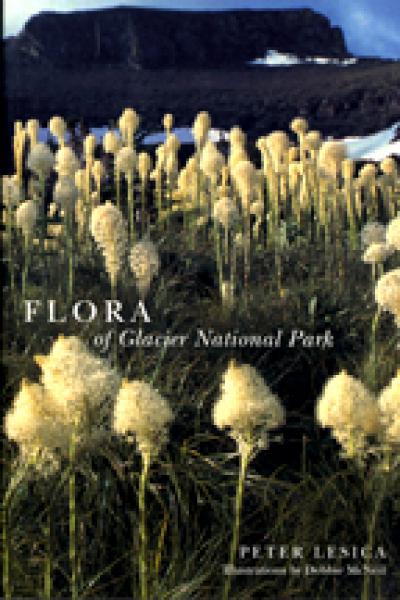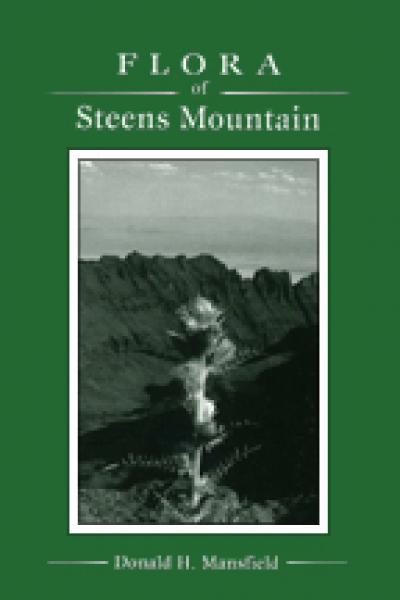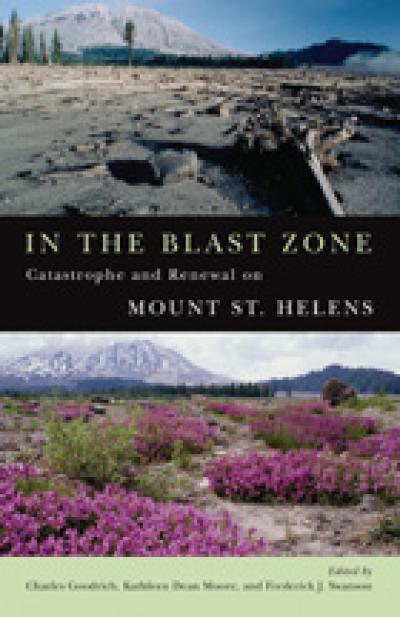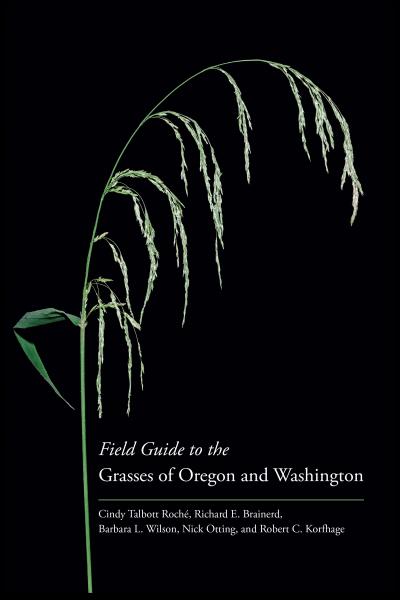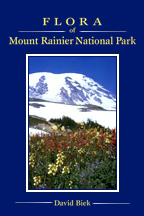
Flora of Mount Rainier National Park
David Biek
"Every one of these parks... is a garden filled knee-deep with fresh, lovely flowers of every hue, the most luxuriant and the most extravagantly beautiful of all the alpine gardens I ever beheld in all my mountain-top wanderings," wrote John Muir, describing his ascent of Washington's Mount Rainier, the highest peak in the Cascade Mountains.
So impressed was Muir with the beauty of Rainier's meadows and forests that he joined others in calling for the establishment of a national park. Coinciding with this year's centennial of the founding of Mount Rainier National Park is a publication of a comprehensive new flora for the Park.
Flora of Mount Rainier National Park provides a complete listing of the 866 species of native and introduced plants found in the Park, with keys, line drawings, and descriptions for identification, as well as a guide to plant location. It includes information on the Park's natural history, as well as sections on botanical exploration, rare plants, and the ecological impact of the Park's 2 million annual visitors.
This authoritative treatment of the Park's flora offers a complete reference and field guide for visitors, as well as naturalists, resource managers, and conservationists. It will prove invaluable to professional and amateur students of Northwest flora.
About the author
David Biek is a librarian with the Tacoma Public Library. He lives in Tacoma, Washington.
Read more about this author
Acknowledgments
Introduction
About the Park
Forest and Plant Communities
Plant Geography and Distribution
Weeds in the Park
Rare Plants in the Park
Early Botanical Explorations
Recent Studies of the Park Flora and Ecology
Key to the Major Groups of Vascular Plants at Mount Rainier National Park
Ferns and Fern Allies
Gymnosperms — Conifers
Angiosperms — Dicotyledonous Plants (Dicots)
Monocotyledonous Plants (Monocots)
Appendix
Plants Added to the Flora of Mount Rainier National Park
Doubtful and Excluded Species
Afterword
Glossary
Bibliography
Index
"Every one of these parks, great and small, is a garden filled knee-deep with fresh, lovely flowers of every hue, the most luxuriant and the most extravagantly beautiful of all the alpine gardens I ever beheld in all my mountaintop wanderings."
Thus wrote John Muir, describing the subalpine meadows of Mount Rainier. Words of high praise from a man who spent most of his life trekking across North America, from the northwoods of Wisconsin, to the Appalachians, west to the "Range of Light," California's Sierra Nevada, and beyond it to the "sweet bee-garden" of the Great Valley. In 1888, at the age of fifty, with much of his roaming behind him, Muir made an ascent of Mount Rainier, in the company of Philemon Van Trump and seven others. Leaving the deep forests at the Mountain's feet, Muir and his party departed the Inn at Longmire, climbed the ridge bordering the Nisqually River, and passed through the flower fields of the Paradise valley, the greatest of the Mountain's "parks." The party bivouacked high above the Paradise meadows, on the south side of the Mountain at 10,062 feet, a place now known as Camp Muir.
Muir's voice was one of those calling for the establishment of a national park to preserve the beauty and grandeur of Mount Rainier, and on March 2,1899, by an act of Congress, Mount Rainier National Park was founded.
In 1893, land in the area of the present national park had been set aside as the Pacific Forest Reserve (called on some maps the Mount Rainier Forest Reserve). Additions of adjacent land were made through 1931, but by 1945 it had become clear that aggressive logging to the north, south, and west of the parcel precluded the incorporation of any more land within the National Park.
Although at the present time some of the Park is surrounded by National Forests and Wilderness Areas, much neighboring land is owned by private timber companies, and in places their clearcuts reach to the Park boundary. The Park, to an unhappy extent, is an island in the midst of a landscape that has been greatly modified by human activities over the past one hundred years, a biogeographical island where plant communities are preserved that outside the Park are becoming more rare.
The most recent comprehensive flora, The Flowering Plants and Ferns of Mount Rainier, was published in 1938 by George Neville Jones, of the University of Washington. Since then, a number of books have been written, designed to acquaint visitors and students of natural history with the flora of the Park. Park Naturalist C. Frank Brockman published a popular flora in 1947, and beautifully illustrated flower books continue to appear, books such as Wildflowers of Mount Rainier and the Cascades, by Mary Fries, with photographs by Bob and Ira Spring; Mountain Plants of the Pacific Northwest, by Ronald Taylor and George Douglas; and Wayside Wildflowers of the Pacific Northwest, by Dee Strickler.
Since the publication of Jones's 1938 flora, many additional plants have been discovered in the Park and numerous changes in nomenclature have been made. Meanwhile, decades of geological, ecological, and botanical research have greatly increased our understanding of the plants and plant communities of Mount Rainier. A new flora of the Park, therefore, is needed. It is my hope that the present work will serve as well and as long as Professor Jones's work did.
The flora of Mount Rainier National Park comprises 871 species, subspecies, and varieties. The 723 that are native plants constitute about 30% of the total native flora of Washington state. The land area of the Park is just under 0.6% of the state's 66,5 11 square miles, making Mount Rainier National Park an excellent place to see a significant portion of the flora of the state.
Throughout this book you will find Mount Rainier referred to as "the Mountain." The use of the noun as a proper name goes back a long way and is meant to convey awe and familiarity, respect and pride.
How to Use This Book
Scope and Intent
My aim in this treatment of the flora of Mount Rainier National Park is to provide a complete list of the native and introduced plants found in the Park, with keys and descriptions sufficient to distinguish each species from the others. Some species get more descriptive detail than others, for the keys serve also to provide descriptive data. The descriptions do not, however, constitute complete data on each plant. Such information is widely available in a number of works cited in the bibliography.
The keys are designed to work for the plants known to occur in the Park and should not be relied on to provide trustworthy results in regions away from the Park. The plants listed have been verified by examination of herbarium specimens, field observations, and reliable reports. No plant is listed solely because it is "expected to occur" in the Park, although a small number of such plants are mentioned at appropriate places in the text.
Much research has been done in the Park since 1938, when George Neville Jones published The Flowering Plants and Ferns of Mount Rainier. Many additional plants have been discovered, among them an unfortunate number of nonnative plants (sometimes called "weeds") that have become established in the Park. Seventy-five plants not previously recorded as growing in the Park were noted in the course of the preparation of the book. I also show that 34 species attributed to the Park's flora, by Jones and by other writers, are not actually to be found on Mount Rainier. The new and excluded species are discussed in an appendix.
This new flora, then, is both a commemoration of the centennial of the founding of Mount Rainier National Park and, I hope, a contribution toward a deeper understanding of the natural systems preserved within the Park.
Information about Each Plant
Each entry for a plant shows the name of the plant in boldface italic. The name of the genus and species is followed by an abbreviation of the name of the author of that scientific name. Common names are included, and largely follow Hitchcock and Cronquist (1976), supplemented by names used by Nelsa Buckingham (Buckingham et al., 1995).
The descriptions are written with a minimum number of technical terms. The glossary (page 477) should be consulted for unfamiliar terms, and from professional botanists I ask indulgence where I use common English terms instead of precise scientific language. Each species is described, and when there is more than one species in a genus the essential characteristics of that genus are described as well. The same is true when there is more than one genus in a family.
A general statement describes habitat and ecological information about the plant. This is followed by a list of places where the plant is known to occur, with an emphasis on those places within easy reach from a road. Location information came from herbarium collections, reliable reports, and my own observations; the locations given are not meant to completely represent the occurrence of the plant, but should serve to help predict other places in which the plant might be found.
A common name is given for each species. Some of these names enjoy wide recognition and use, such as mountain hemlock, red alder, and thimbleberry. Others are less well-known but still genuinely common, such as white-vein shinleaf and clustered rose. A third group of common names are those that are essentially translations of the scientific names, such as Fendler's waterleaf and creeping sibbaldia. In some cases, the common name is a compound hyphenated name, such as dog-fennel (Anthemis) or marsh-marigold (Caltha). This convention is followed to show that these plants may resemble but are not, respectively, a true fennel (Foeniculum) or a true marigold (Tagetes).
Measurements of plants are expressed in metric units. Measurements of distance and elevation are in the common English units found on maps and odometers. A metric scale is printed on the back cover for easy reference.
The following abbreviations are used:
| cm | centimeter | Cr | Creek | fl | flower |
| ft | foot | Hwy | Highway | fls | flowers |
| mm | millimeter | Lk | Lake | If | leaf |
| m | meter | Lks | Lakes | Ivs | leaves |
| ssp. | subspecies | Mtn | Mountain | ||
| var. | variety | R | River | ||
| Rd | Road | ||||
| V | Valley |
Nonvascular plants--mosses, liverworts, and lichens--are prominent members of the Park's flora but are not included in this book. The best available guidebooks for their study are Mosses, Lichens and Ferns of Northwest North America by Dale H. Vitt (1993) and Macrolichens of the Pacific Northwest by Bruce McCune and Linda Geiser (1997).
Using the Keys
Each key consists of one or more pairs of contrasting statements, each pair called a couplet. Observe the specimen in light of the characteristics described in the statements and choose the statement that best describes the specimen. At this point, you may have the name of a species, or you may have a number. The number refers to another couplet, and so it proceeds until you've "keyed out" the plant. Keying out isn't the same thing as identification, however, and the final step in the process always is to read the full description of the plant, compare it to the illustration, and be sure of the match.
You may find that the description doesn't seem to fit; in that case, it is necessary to work your way back through the key. Consider this example from the key to the huckleberries:
7(6) Leaf margins markedly toothed from base to tip; tips of the
leaves long-pointed ............................ V membranaceum
7 Leaf margins nearly toothless to weakly toothed, generally below
the midpoint, tips of the leaves short-pointed to rounded ......... 8
Suppose you've arrived at couplet 7 and selected the first statement, but discovered after reading the description of Vaccinium membranaceum that the plant fails in some way to match the description. You would go on to try couplet 8, but it might happen that no species you find further in the key fits either. You know you will have to backtrack, but to what point?
The "6" in parentheses indicates that you reached couplet 7 from a reference in couplet 6. Refer back to couplet 6 and reconsider the choice you made there. In a short key, this back reference number may seem unnecessary, but in a long key it is easy to lose track. Even in a short key, the reference will be helpful for those new to the use of identification keys.
Within each major division (except for the ferns), families are listed alphabetically. This is also true for genera within families and species within genera.
Plant Names
Many of the names used by Jones in 1938 are no longer accepted as correct. The plants haven't changed, but botanists' concepts of how to define species and how species are related to each other have, and changes of this sort are often accompanied by changes in names. Even the most recently published flora for the region, Hitchcock and Cronquist's Flora of the Pacific Northwest (1976), is out of date with respect to advances in botany. (Indeed, this book, too, will be out of date the instant it is printed. To keep abreast of changes of this sort, consult the sources listed below.)
The authority for plant names for this book, at the level of genus, species, and subspecies or variety, is A Synonymized Checklist of the Vascular Flora of the United States, Canada, and Greenland by John T. Kartesz (second edition, Timber Press, 1994). This work is out of print but is widely available through libraries. Throughout the text, unless otherwise noted, a reference to "Kartesz" is a reference to the 1994 edition. A revision, with changes incorporated by Kartesz through the summer of 1998, is not available in print, but will be found on the World Wide Web at: <http://www.csdi.tamu.edu/FLORA/newgate/crlfamzz.htm>.
The PLANTS database established by agencies of the U.S. Department of Agriculture (USDA) as the standard for the federal government uses Kartesz's 1998 online work as its name authority. The PLANTS database provides information on the geographic occurrence of plants, wetland status, other basic information, and photographs. It, too, does not exist in print, but may be consulted at: <http://plants.usda.gov/plants>.
Botanical nomenclature, the scientific names applied to plants, has been subject to change, and the literature on the flora of the Park is replete with names that are no longer accepted for use. Many of these are synonyms, while some are valid names that have been used incorrectly (or "misapplied") for plants at Mount Rainier. The index to this book includes entries for synonyms and misapplied names.
Family names and definitions follow the system proposed by James L. Reveal. A number of systems for the classification of higher groups of plants have been proposed to replace the system used in Hitchcock and Cronquist's flora for the Northwest. Those interested in matters of classification above the level of the genus may want to examine the USDA:s APHIS concordance of family names at: .
At a few particular points, I have chosen not to follow these authorities. In each such case, I present my reasoning, which is usually based on advice from experts on a species or group of species, especially those who are writing treatments for the Flora of North America. This massive project has published three volumes to date (for the ferns, conifers, and two subclasses of the flowering plants. Published text may be found on the Web at: .
The full name of each species always includes the name of the author, the scientist who first published the name and description of that species. For example, Draba aureola S. Watson was first described by Sereno Watson. Authors' names are standardized as well, and are taken from "W3 Tropicos" , which follows and updates Brummit and Powell (1992).
About the Park
Location and Topography
Mount Rainier National Park is located in Pierce and Lewis Counties, Washington, about 55 miles southeast of downtown Seattle. Established by an Act of Congress as the nation's fifth national park on March 2, 1899, the original boundaries formed a square, 18 miles on each side. Earlier, in 1893, Congress had established the Pacific Forest Reserve, a much larger tract of land whose western border fell just east of Mowich Lake and whose eastern border was about halfway between the Cascade Divide and Yakima. Following the establishment of the Park, the southern border was expanded to include the Ohanapecosh area and the eastern border was drawn along the Cascade Divide. Today, the Park covers 235,612 acres, or 368 square miles.
The summit of Mount Rainier, the highest of the Cascade volcanoes, is located at 46o51 " north latitude and 121o46" west longitude. The height of the Mountain has been disputed: the U.S. Geological Survey gives the height as 14,410 feet, whereas the Washington Centennial Commission, using satellite instrumentation, set the figure at 14,411 feet. The Mountain itself occupies about one-third of the area of the Park, and one-quarter of the land in the Park is bare alpine rock, ice, and permanent snowfields. Although dwarfed by the mass of Rainier, Little Tahoma Peak, on the east side of the Mountain, is the third highest peak in Washington State, at 11,138 feet.
The major entrances to the Park lie between 2 and 2.5 miles below the summit: The Ohanapecosh and Carbon River entrances are both at 1,760 feet, the Nisqually entrance is at 2,003 feet, and the White River entrance is at 2,725 feet.
Much of the Park is surrounded by National Forest land: the Mount Baker-Snoqualmie National Forest on the north and east sides, the Gifford Pinchot National Forest on the south. Four wilderness areas also abut the Park: the Glacier View Wilderness at the southwest corner, the Clearwater Wilderness on the northwest, the Naches Peak Wilderness on the northeast, and the William 0. Douglas Wilderness along much of the eastern border of the Park. A good portion of the western border, in Pierce County, is privately owned and much has been clearcut. Indeed, the view of this side presented by satellite photography shows a stark border between the deep green forests of the Park and the lighter green of cutover and second-growth woodlands.
The Park itself lies wholly to the west of the Cascade Divide. Mount Rainier is located a short distance west of the center of the Park, and its snow and ice give rise to each of the major rivers of the Park. These are, beginning on the north side and moving counterclockwise around the Mountain, the White, Carbon, Mowich, the north and south forks of the Puyallup, Nisqually, Paradise, Cowlitz, and Ohanapecosh Rivers. The latter two rivers join and meet the Columbia River at Longview, Washington, downstream from Portland, while the others all reach Puget Sound.
The valleys of these rivers are narrow and steep-sided on the flanks of the Mountain, wider and broader as the lowlands are reached. They can lie 1,000 to 3,000 feet below the rocky ridges that divide them. Rivers flow swiftly and there are relatively few lakes in the Park. Those lakes that are found tend to be small and located on the periphery of the Park. The largest is Mowich Lake, at almost 123 acres.
97% of the Park is designated wilderness; areas reachable by road are few, and were made even fewer in the 1990s by recurring damage to the road approaching the Carb on River entrance and to Westside Road. The Park's annual count of about two million visitors is funneled, then, into a relatively small amount of space, some of the consequences of which are described in subsequent sections of the Introduction.
Climate
The location of the Park on the west side of the Cascade Divide is significant and well illustrated by the dramatic change in vegetation one sees along the road east from Chinook Pass. Although Mount Rainier is located at a latitude roughly equal to that of Michigan's Upper Peninsula, the area enjoys a moderate climate, for the influence of the nearby Pacific Ocean brings both cool temperatures and heavy rain and snow.
About 25% of the annual precipitation falls between June and September, although only July and August can be considered reliably warm and dry (barring the occasional thundershower). The winter's first snows typically arrive late in September. Snow depths can range from an average midwinter accumulation at Longmire of some 4 feet to more than 50 feet at Paradise. A record for North America was set in the winter of 19711972, when 1,122 inches (more than 93 feet) of snow fell at Paradise. Snow turns to rain sometime between March and April, when the blooming season begins at the Park's lower elevations. In some years, flowing in the meadows at Paradise doesn't begin until well into July.
The most complete climate records are kept at the Paradise Ranger Station. The figures in the table on the following page are averages, compiled for the period 1965-1994.
It has been said by many that Mount Rainier creates its own weather. The Mountain is so massive that it produces its own rain shadow, as winter storms arriving from the southwest drop their moisture on the south and west sides. This leaves Sunrise, on the northeast side, comparatively dry: winter snow accumulation there is typically half that at Paradise and the growing season is longer. Special microclimates around the Park result from unique interactions of landforms and weather patterns. For example, snow accumulations at Cayuse Pass, due east of the Mountain, can exceed those at Paradise. Snow depth at some alpine locations is reduced by winds that sweep away the snow, and on ridges around Sunrise the winter ground can be free of snow. Some studies there suggest that weather at Sunrise is
| Jan | Feb | Mar | Apr | May | Jun | Jul | Aug | Sep | Oct | Nov | Dec | Year | |
|
|
|||||||||||||
| Temperature (oF) | |||||||||||||
| Max. | 31.8 | 34.0 | 36.4 | 40.4 | 47.8 | 53.6 | 60.5 | 61.7 | 56.0 | 47.4 | 35.5 | 32.0 | 44.8 |
| Min. | 20.2 | 21.6 | 22.7 | 25.1 | 30.8 | 36.6 | 42.2 | 43.6 | 39.2 | 32.7 | 24.0 | 20A | 29.9 |
| Mean | 26.0 | 27.8 | 29.6 | 32.8 | 39.4 | 45.1 | 51.4 | 52.7 | 47.6 | 40.1 | 29.7 | 26.2 | 37.4 |
| Precipitation (inches) | |||||||||||||
| 18.2 | 13.2 | 11.6 | 8.7 | 5.1 | 3.9 | 1.9 | 2.4 | 4.8 | 8.7 | 17.4 | 18.4 | 114.2 | |
| Snowfall (inches) | |||||||||||||
| 131.6 | 101.3 | 98.7 | 72.1 | 25.2 | 6.2 | 0.6 | 0.0 | 3.4 | 28.8 | 97.2 | 121 | 686.1 | |
Note: No day was recorded during this period when the temperature exceeded 90oF. Indeed, summer days reaching 80oF are rare. A temperature below OoF was recorded just twice. Freezing temperatures and snow can occur any day of the year at Paradise.
Source: Weather America, edited by Alfred N. Garwood. Toucan Valley Publications, 1996.
more unstable earlier in the summer but more moderate later. At lower elevations, of course, much more precipitation falls in the form of rain.
The heaviest amount of rain (180210 inches per year) falls in the northwest comer of the Park, in the Carbon River valley. Here, the abundant moisture and low elevation produce a true temperate rain forest, of the type found on the west side of the Olympic Peninsula.
While rain is sparse in the summer months, it sometimes happens that the higher ridges are enveloped in fog and clouds. At such times, enough moisture can condense on the needles of conifers that a small amount of "rain" actually falls at the base of a tree.

